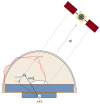The Implementation of Precise Point Positioning (PPP): A Comprehensive Review
- PMID: 37960573
- PMCID: PMC10650808
- DOI: 10.3390/s23218874
The Implementation of Precise Point Positioning (PPP): A Comprehensive Review
Abstract
High-precision positioning from Global Navigation Satellite Systems (GNSS) has garnered increased interest due to growing demand in various applications, like autonomous car navigation and precision agriculture. Precise Point Positioning (PPP) offers a distinct advantage over differential techniques by enabling precise position determination of a GNSS rover receiver through the use of external corrections sourced from either the Internet or dedicated correction satellites. However, PPP's implementation has been challenging due to the need to mitigate numerous GNSS error sources, many of which are eliminated in differential techniques such as Real-Time Kinematics (RTK) or overlooked in Standard Point Positioning (SPP). This paper extensively reviews PPP's error sources, such as ionospheric delays, tropospheric delays, satellite orbit and clock errors, phase and code biases, and site displacement effects. Additionally, this article examines various PPP models and correction sources that can be employed to address these errors. A detailed discussion is provided on implementing the standard dual-frequency (DF)-PPP to achieve centimeter- or millimeter-level positioning accuracy. This paper includes experimental examples of PPP implementation results using static data from the International GNSS Service (IGS) station network and a kinematic road test based on the actual trajectory to showcase DF-PPP development for practical applications. By providing a fusion of theoretical insights with practical demonstrations, this comprehensive review offers readers a pragmatic perspective on the evolving field of Precise Point Positioning.
Keywords: GNSS; IGS; PPP; PPP corrections; PPP errors; precise positioning.
Conflict of interest statement
The authors declare no conflict of interest. The funders had no role in the design of the study; in the collection, analysis, or interpretation of data; in the writing of the manuscript; or in the decision to publish the results.
Figures








References
-
- Misra P., Enge P. Global Positioning System: Signals, Measurements and Performance Second Edition. Ganga-Jamuna Press; Lincoln, MA, USA: 2006.
-
- Counselman C.C., III, Shapiro I.I., Greenspan R.L., Cox D.B., Jr. Radio Interferometry Techniques for Geodesy. NASA, Massachusetts Institute of Technology; Cambridge, MA, USA: 1979. Backpack VLBI terminal with subcentimeter capability; pp. 409–414.
-
- Counselman C.C., Gourevitch S.A. Miniature interferometer terminals for earth surveying: Ambiguity and multipath with global positioning system. IEEE Trans. Geosci. Remote Sens. 1981;GE-19:244–252. doi: 10.1109/TGRS.1981.350379. - DOI
-
- El-Rabbany A. Introduction to GPS: The Global Positioning System. Artech House; Norwood, MA, USA: 2002.
-
- Kaplan E., Hegarty C. Understanding GPS: Principles and Applications. Artech House; Norwood, MA, USA: 2006.
Publication types
LinkOut - more resources
Full Text Sources
Miscellaneous

